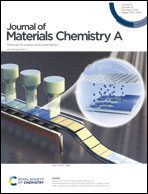Electrochemical CO2 reduction: water/catalyst interface versus polymer/catalyst interface†
Abstract
Due to the low solubility and diffusion coefficients of carbon dioxide in aqueous solutions, it is difficult to achieve high conversion current density using carbon dioxide electrolytic cells with aqueous electrolytes. The appearance of alkaline polymer electrolyte electrolytic cells (APEECs) brings hope to solve this problem. However, the veil on the details of CO2 reduction in APEECs has not been lifted, which hinders their performance improvements. In this study, the electrochemical reduction of carbon dioxide at the aqueous solution/copper interface and polymer electrolyte/copper interface were compared by first principles calculations to present a fundamental understanding of the superiority of APEECs. Through advanced molecular dynamics simulations, full reaction energetics at the operation potential are obtained. It was identified that the polymer electrolyte/copper interface exhibited a high turnover frequency mainly because of breaking away from the restrictions of aqueous-based systems. Moreover, our microkinetic model results show that by adjusting the hydroxyl ion concentration and water content of the polymer electrolyte, the conversion current density of APEECs can be further increased to two orders of magnitude higher than that of aqueous-based electrolytic cells.



 Please wait while we load your content...
Please wait while we load your content...